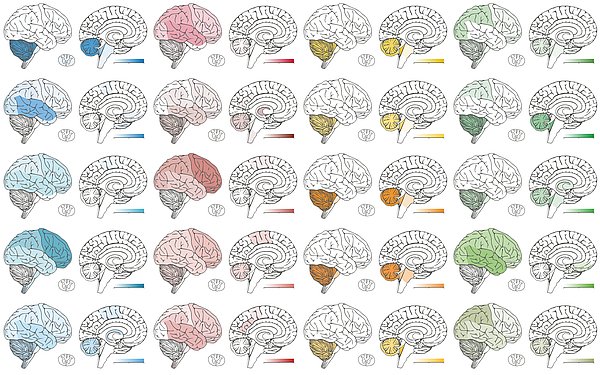The Hopp Children’s Cancer Center Heidelberg (KiTZ) is a joint institution of the German Cancer Research Center (DKFZ), Heidelberg University Hospital (UKHD) and the University of Heidelberg (Uni HD).
Cancer in children and adolescents is different from cancer in adults, and this is reflected in its diversity. There are more than 150 subtypes of tumors of the central nervous system in children - many times more than in adults. "Depending on the tumor class, radiation and chemotherapy also have very different effects. Classifying the tumors as precisely as possible is therefore quite crucial for effective treatment," emphasizes the head of the study, David Jones, department head at the Hopp Children's Tumor Center Heidelberg (KiTZ) and the German Cancer Research Center (DKFZ).
For a long time, looking through a microscope was crucial for cancer diagnosis. According to the World Health Organization (WHO) classification, until recently most brain tumors were classified into tumor groups mainly on the basis of their tissue characteristics. "This expert knowledge is also still indispensable for making a diagnosis. However, it is not possible to classify all tumor types more accurately based on their tissue structure alone. Moreover, some tumor types are so rare that even experienced pathologists almost never get to see them," Jones says.
In 2018, a team of researchers led by Stefan Pfister, director at KiTZ, department head at DKFZ and pediatric oncologist at Heidelberg University Hospital (UKHD), in close cooperation with the Department of Neuropathology at UKHD with Andreas von Deimling and Felix Sahm, had published a new AI-based method in the journal Nature for the first time and made it available worldwide. The algorithm, known as the "Heidelberg Brain Tumor Classifier", evaluates so-called DNA methylations in the genetic material of the tumor. The complex pattern of methyl markings with which our DNA is provided forms a second level of information - in addition to the hereditary information that is laid down in the base sequence of the DNA. The methylations mark genes and the cell can thereby control their activity. A large number of studies have already shown that not only cancer cells and healthy cells differ in their methylation pattern, but also different types of tumors.
The task of AI is to use the methylation data to identify a fingerprint for each tumor group that is as distinctive as possible in order to refine the diagnosis. Since its first online launch, the Brain Tumor Classifier has evaluated more than 100,000 tumor samples that have been uploaded worldwide to the www.molecularneuropathology.org platform for research purposes.
The current study now concludes that the method significantly improves the accuracy of previously established diagnostic procedures and thus enables even more personalized treatment.
It is the first study that has been able to verify the reliability of methylation profiles for cancer diagnosis in children, also through longer observations of disease progression. In 1,200 newly diagnosed childhood and adolescent brain tumors, the research team compared the diagnosis made using previous WHO criteria with the AI result. In half of the patients, the diagnosis basically matched the original WHO classification, but the AI analysis allowed for a more accurate classification of the tumor into specific subgroups. "Some of the identified methylation patterns are so specific that the AI can even use them to make statements about the estimated age and sex of the child as well as the location of the tumor," explains Dominik Sturm, lead author of the study and a pediatrician at KiTZ and UKHD.
In addition to the methylation data, the research team, in close cooperation with the Department of Human Genetics at the UKHD, also analyzed the genetic information of certain genes associated with cancer to refine the diagnosis. In almost 50 percent of those affected, the scientists discovered genetic alterations that are crucial for making a diagnosis or that can be used therapeutically. In 10 percent of the cases, the research team also discovered a hereditary cancer risk. "Identifying hereditary causes of cancer at diagnosis can help cancer treatment make the right treatment decision," Sturm explains. "Affected families can get advice on their genetic cancer risk and, for example, take advantage of certain screenings for siblings and other affected family members."
Deviations from the diagnosis made according to WHO criteria occurred particularly in young patients with high-grade gliomas - especially aggressively growing brain tumors. In about 15 percent of these patients, the AI found that they were not high-risk tumors but low-grade gliomas with a much more favorable prognosis. In fact, follow-up over several years confirmed that these patients had a significantly more favorable disease course and better survival than would have been the case with high-grade glioma. "This group of patients could therefore particularly benefit from the new procedure," says David Jones.
A new edition of the WHO classification of tumors of the central nervous system, which was jointly developed by scientists at KiTZ, UKHD and DKFZ, as well as numerous other international experts, was published only recently. It is based for the first time on a modern, multi-layered approach in which methylation patterns are now also firmly established. "Our study shows that the combination with AI-based methods can significantly improve precision diagnostics for children and adolescents with brain tumors," says Stefan Pfister. "Also, in countries where there are often too few specialized pathologists to evaluate tumor samples, these methods could help to standardize on more precise diagnostic approaches specifically for children with cancer. We are just starting to investigate this with partner institutions in Africa and Asia."
Original publication:
Sturm, D. et al. Multiomic neuropathology improves diagnostic accuracy in pediatric neuro-oncology. In: Nature Medicine (Online Publikation March 16, 2023) DOI: 10.1038/s41591-023-02255-1
Further information:
Platform of AI-assisted method to analyze methylation profiles in pediatric and adolescent CNS tumors MolecularNeuropathology.org




